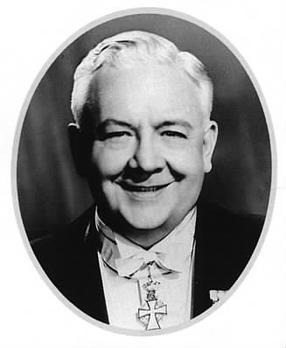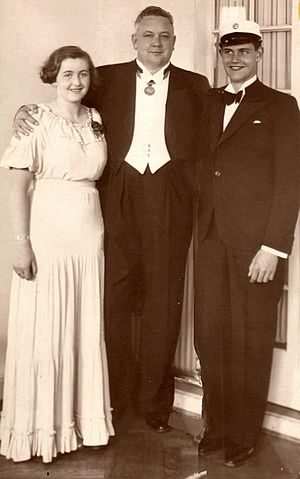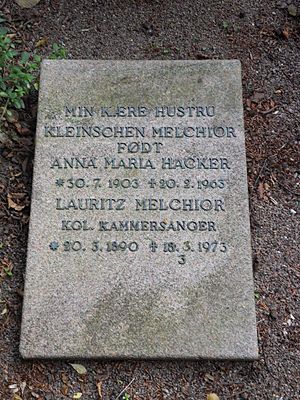Lauritz Melchior facts for kids
Lauritz Melchior (born March 20, 1890 – died March 18, 1973) was a famous opera singer from Denmark and America. He was known as the best Wagnerian tenor (a type of male opera singer) during the 1920s, 1930s, and 1940s. Many people think he was the perfect example of this voice type. Later in his life, Melchior also acted in movie musicals, and appeared on radio and TV shows. He also recorded many songs.
Contents
About Lauritz Melchior's Life
Early Years and First Steps in Opera
Lauritz Lebrecht Hommel Melchior was born in Copenhagen, Denmark. When he was young, he sang as a treble (a high boy's voice) and was an amateur singer. At 18, in 1908, he began studying opera singing at the Royal Opera School in Copenhagen.
In 1913, Melchior made his first opera appearance. He sang the baritone role of Silvio in Pagliacci by Ruggero Leoncavallo at the Royal Danish Theatre in Copenhagen. For the next few years, he mostly sang smaller baritone and bass roles for the Royal Danish Opera and other opera companies in Scandinavia.
One night, while on tour, Melchior helped a soprano (a female opera singer) who was not feeling well. He sang a high note for her in the opera Il trovatore. The American contralto (a low female voice) Sara Cahier, who was also performing, was very impressed. She told him he was not a baritone, but a tenor (a high male voice) who was holding back. She even asked the Royal Opera to give him time off and money to re-study his voice.
From 1917 to 1918, Melchior took lessons from the famous Danish tenor Vilhelm Herold. This was a big change for Melchior's career. His high baritone voice was trained to become a low tenor voice, but with strong high notes. His second debut was on October 8, 1918. He sang the main role in Tannhäuser at the Royal Opera in Copenhagen.
In 1920, Melchior visited England to sing in an early radio broadcast. He often performed in London, including at Sir Henry J. Wood's Prom Concerts.
Becoming a Leading Heldentenor
News of Melchior's talent spread. Cosima Wagner and Siegfried Wagner at Bayreuth heard about him. The Bayreuth Festival was getting ready to reopen in 1924. Melchior was hired to sing the roles of Siegmund and Parsifal there. This important contract led to other performances, like a Wagner concert in Berlin in 1923.
On May 14, 1924, Lauritz Melchior made his debut at the Royal Opera House in London. He sang as Siegmund, and it was a huge success. A few weeks later, Melchior also performed at the Festspielhaus in Bayreuth. He sang the roles of Siegmund and Parsifal there.
On February 17, 1926, he sang for the first time at the Metropolitan Opera in New York City. He performed as Tannhäuser. In his first season, Melchior sang only eight times. To improve his skills and gain more experience, he took a job at the Hamburg State Opera. There, he sang roles like Lohengrin, Otello, and Radames in Aida. He also sang regularly at other major German opera houses.
Melchior sang in many theaters and concert halls around the world during his long career. However, he is best known for his time at the Metropolitan Opera. He performed in 519 Wagnerian roles there between 1926 and 1950. Melchior's big breakthrough at the Metropolitan Opera happened when he performed in Tristan und Isolde on March 20, 1929. After this, his career really took off.
Melchior performed at Covent Garden in London from 1924 to 1939. He sang Wagnerian roles, and also Otello and Florestan. Other important places he sang were in Buenos Aires (1931–1943), San Francisco Opera (1934–1945), and Chicago Opera (1934–1945). His last stage performance was on February 2, 1950, when he sang Lohengrin's Farewell.
Some of Melchior's famous colleagues included sopranos like Frida Leider, Kirsten Flagstad, and Helen Traubel. He also worked with well-known conductors such as Bruno Walter and Arturo Toscanini.
New Directions: Movies and TV
Between 1944 and 1952, Melchior acted in five Hollywood musical films for Metro-Goldwyn-Mayer and Paramount Pictures. He also appeared many times on US radio and television. In 1947, he placed his hand and footprints in cement at Grauman's Chinese Theatre in Hollywood.
From 1946 to 1949, Melchior went on a world tour with his conductor Ezra Rachlin. Their visit to Denmark was special because they were guests of King Frederick IX. The King was an amateur conductor and had his own concert hall in his palace.
In 1952, Melchior performed at New York's Palace Theatre. He followed the popular singer and actress Judy Garland, who had a very successful show there.
After he unofficially retired around 1955, Melchior still sang sometimes. He occasionally sang the national anthem at Dodgers baseball games in Los Angeles. In the late 1960s, he started a fund at the Juilliard School. This fund, called "The Lauritz Melchior Heldentenor Foundation," helps train future heldentenors.
In the 1960s, he appeared on The Danny Thomas Show on TV. He sang with Shirley Jones, playing her father, to help her start her singing career.
In the summer of 1972, Melchior conducted the San Francisco Opera Orchestra. This was part of the company's 50th anniversary celebration and one of his last public appearances.
Death and Legacy
Melchior became an American citizen in 1947. He died in Santa Monica, California, in 1973, two days before his 83rd birthday. He was buried in the Assistens Kirkegaard cemetery in Copenhagen. His son, Ib Melchior, who was a novelist and filmmaker, wrote a book about his father.
Recordings
Melchior made many recordings throughout his career. He first recorded as a baritone for Danish HMV. Later, as a tenor, he recorded for Deutsche Grammophon (1923–1930), English and German HMV (1927–1935), RCA Victor (1938–1941), American Columbia (1942–1950), and finally Warner Bros. His last performance for Danish radio was in 1960. He sang the first act of Die Walküre to celebrate his 70th birthday, and this was released as a recording.
Filmography
| Year | Title | Role | Notes |
|---|---|---|---|
| 1945 | Thrill of a Romance | Mr. Nils Knudsen | |
| 1946 | Two Sisters from Boston | Olstrom | |
| 1947 | This Time for Keeps | Richard Herald | |
| 1948 | Luxury Liner | Olaf Eriksen | |
| 1953 | The Stars Are Singing | Jan Poldi |
See also
 In Spanish: Lauritz Melchior para niños
In Spanish: Lauritz Melchior para niños





